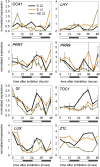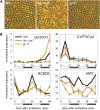A role for multiple circadian clock genes in the response to signals that break seed dormancy in Arabidopsis
- PMID: 19542296
- PMCID: PMC2714941
- DOI: 10.1105/tpc.108.064022
A role for multiple circadian clock genes in the response to signals that break seed dormancy in Arabidopsis
Abstract
Plant seeds can sense diverse environmental signals and integrate the information to regulate developmental responses, such as dormancy and germination. The circadian clock confers a growth advantage on plants and uses environmental information for entrainment. Here, we show that normal circadian clock gene function is essential for the response to dormancy-breaking signals in seeds. We show that mutations in the clock genes LATE ELONGATED HYPOCOTYL, CIRCADIAN CLOCK ASSOCIATED1 (CCA1), and GIGANTEA (GI) cause germination defects in response to low temperature, alternating temperatures, and dry after-ripening. We demonstrate that the transcriptional clock is arrested in an evening-like state in dry seeds but rapidly entrains to light/dark cycles in ambient temperatures upon imbibition. Consistent with a role for clock genes in seed dormancy control, CCA1 expression is transcriptionally induced in response to dry after-ripening and that after-ripening affects the amplitude of subsequent transcriptional clock gene oscillations. Control of abscisic acid- and gibberellin-related gene expression in seeds requires normal circadian function, and GI and TIMING OF CAB EXPRESSION1 regulate the response to ABA and GA in seeds. We conclude that circadian clock genes play a key role in the integration of environmental signaling controlling dormancy release in plants.
Figures








Similar articles
-
CHOTTO1, a putative double APETALA2 repeat transcription factor, is involved in abscisic acid-mediated repression of gibberellin biosynthesis during seed germination in Arabidopsis.Plant Physiol. 2009 Oct;151(2):641-54. doi: 10.1104/pp.109.142018. Epub 2009 Jul 31. Plant Physiol. 2009. PMID: 19648230 Free PMC article.
-
AtPER1 enhances primary seed dormancy and reduces seed germination by suppressing the ABA catabolism and GA biosynthesis in Arabidopsis seeds.Plant J. 2020 Jan;101(2):310-323. doi: 10.1111/tpj.14542. Epub 2019 Oct 22. Plant J. 2020. PMID: 31536657
-
The time required for dormancy release in Arabidopsis is determined by DELAY OF GERMINATION1 protein levels in freshly harvested seeds.Plant Cell. 2012 Jul;24(7):2826-38. doi: 10.1105/tpc.112.100214. Epub 2012 Jul 24. Plant Cell. 2012. PMID: 22829147 Free PMC article.
-
Molecular networks regulating Arabidopsis seed maturation, after-ripening, dormancy and germination.New Phytol. 2008;179(1):33-54. doi: 10.1111/j.1469-8137.2008.02437.x. Epub 2008 Apr 14. New Phytol. 2008. PMID: 18422904 Review.
-
Interactions between circadian and hormonal signalling in plants.Plant Mol Biol. 2009 Mar;69(4):419-27. doi: 10.1007/s11103-008-9407-4. Epub 2008 Oct 15. Plant Mol Biol. 2009. PMID: 18855103 Review.
Cited by
-
GIGANTEA - an emerging story.Front Plant Sci. 2015 Jan 26;6:8. doi: 10.3389/fpls.2015.00008. eCollection 2015. Front Plant Sci. 2015. PMID: 25674098 Free PMC article. Review.
-
The adaptive nature of the plant circadian clock in natural environments.Plant Physiol. 2022 Sep 28;190(2):968-980. doi: 10.1093/plphys/kiac337. Plant Physiol. 2022. PMID: 35894658 Free PMC article.
-
Regulatory networks of hormone-involved transcription factors and their downstream pathways during somatic embryogenesis of Arabidopsis thaliana.3 Biotech. 2023 May;13(5):132. doi: 10.1007/s13205-023-03546-7. Epub 2023 Apr 19. 3 Biotech. 2023. PMID: 37091499 Free PMC article.
-
Expression of StMYB1R-1, a novel potato single MYB-like domain transcription factor, increases drought tolerance.Plant Physiol. 2011 Jan;155(1):421-32. doi: 10.1104/pp.110.163634. Epub 2010 Oct 27. Plant Physiol. 2011. PMID: 21030505 Free PMC article.
-
Underlying Biochemical and Molecular Mechanisms for Seed Germination.Int J Mol Sci. 2022 Jul 31;23(15):8502. doi: 10.3390/ijms23158502. Int J Mol Sci. 2022. PMID: 35955637 Free PMC article. Review.
References
-
- Ali-Rachedi, S., Bouinot, D., Wagner, M.H., Bonnet, M., Sotta, B., Grappin, P., and Jullien, M. (2004). Changes in endogenous abscisic acid levels during dormancy release and maintenance of mature seeds: Studies with the Cape Verde Islands ecotype, the dormant model of Arabidopsis thaliana. Planta 219 479–488. - PubMed
-
- Bryant, T.R. (1972). Gas exchange in dry seeds: Circadian rhythmicity in the absence of DNA replication, transcription, and translation. Science 178 634–636. - PubMed
-
- Cao, S., Ye, M., and Jiang, S. (2005). Involvement of GIGANTEA gene in the regulation of the cold stress response in Arabidopsis. Plant Cell Rep. 24 683–690. - PubMed
Publication types
MeSH terms
Substances
Associated data
- Actions
- Actions
- Actions
- Actions
- Actions
- Actions
- Actions
- Actions
Grants and funding
LinkOut - more resources
Full Text Sources
Molecular Biology Databases
Research Materials

